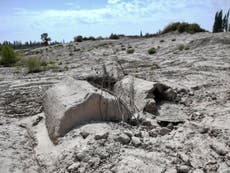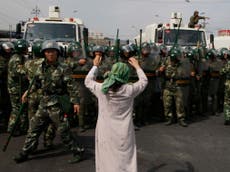USA
'Education deserts' are a 'staggering' problem, and for-profit colleges are taking advantage
Aarthi Swaminathan Reporter,Yahoo Finance•February 18, 2020
Here's how much can you afford to borrow for college
It’s one thing to not be able to afford a college education. It’s an entirely different issue altogether when you don’t even have a college around you.
A recent report from Jain Family Institute (JFI) reveals that access to college isn’t just about the cost of college. Physical access to public higher education institutions across America has also been highly unequal.
Specifically, as detailed by JFI’s interactive map, regions in America’s West have little-to-no access to an institution of higher education, compared to the East Coast.
“One of the major takeaways when you're looking at the map is the staggering amount of populated areas that are considered highly concentrated,” Laura Beamer, higher education finance project lead at JFI and one of the two authors of the study, told Yahoo Finance. “We figured out that roughly 2.4 million prospective students have access to most one public option nearby … Though financial access is extremely important, geographic access is also a very important piece of this dialogue and should be talked about more.”

The concentration of higher education institutions across the U.S., based on whether they were accessible within 30 mins, if one was driving. Red indicates that they were few or no schools within that range, green indicates the opposite. (Graphic: Jain Family Foundation)More
The Rocky Mountain region “is the worst off,” the report added, “followed closely by the Plains region.”
The JFI report — which drew on various points of data from the 2016-17 Integrated Postsecondary Education Data System, enrollment data from 2017, the 2016 5-year population, and median income estimates from the American Community Survey, driving durations to higher ed institutions in the area, zip codes, and more — created a “School Concentration Index” which measures the variation across the higher education market across different types of schools in the U.S. and U.S. territories.
Four states — Idaho, Montana, North Dakota, and Wyoming — were found to have higher education institution monopolies or close to it, meaning that there is only one institution or very few schools to choose from.

Graduates toss their caps in the air after receiving their diplomas at Silver Creek High School in Idaho. (Photo: Matt Jonas/Digital First Media/Boulder Daily Camera via Getty Images)
‘Prime hunting ground for for-profit institutions’
The authors found that a highly concentrated zip code (in red) means that there are few — or in some cases zero — higher education institutions in the area. A low concentration implies that there are a wide variety of options available for prospective students.
In the U.S., 38% of the population lives in highly concentrated zip codes, where they have access to very few or no higher education institutions, according to Beamer and her co-author Marshall Steinbaum, who is also an assistant professor of economics at the University of Utah. If a student from these areas wanted to attend a college or university, their commute would be at least 45 minutes.
The unequal access has wide-ranging implications for prospective students, most of them negative.
Parts of the U.S. where there’s “little to no access” to a higher ed institution “are prime hunting ground for for-profit institutions, just as they are known to draw disproportionately from populations historically excluded from traditional higher ed on the basis of race and class,” the authors argued.
The for-profit higher education sector saw tremendous growth since the financial crisis. In 2016, the New York Fed noted that enrollment at these schools had “skyrocketed” as the country emerged out of the Great Recession. For-profit colleges have also been known to saddle graduates with high levels of student debt, and in some cases, provide low-quality education with false promises of job placement.
The Obama administration’s crackdown on for-profit colleges led to several closures, and recent action by the Federal Trade Commission (FTC) pushed the University of Phoenix to put a stop to deceptive advertising of lucrative job opportunities.
Despite government action, for-profits persist due to these gaps in availability.

A security guard inside Everest College keeps away a member of the media and a former student Gary Montano after the embattled for-profit Santa Ana school was shut down along with 28 others on Monday. (Photo: Mindy Schauer/Digital First Media/Orange County Register via Getty Images)
‘A school could ... possibly practice price discrimination’
So why are schools so unequally distributed across the U.S. in the first place?
“It comes down to the structure that that states have put in place and just haven't been able to update over the last few decades,” Beamer said. “There is a rural versus urban dynamic as well … schools are going to open in places where there's a labor market and where there's a large population of students.”
The biggest problem arising is a neglect of the West, the researchers argue, where “a school could determine prices and access unilaterally and possibly practice price discrimination.”
More broadly, the issues raises a more philosophical question about what higher education represents.
“We have this idea that higher education as a societal institution is egalitarian … there's also a lot of reasons why it isn't,” said Steinbaum. “This is one tiny piece of evidence among a broad painting of the fact that the higher education system is extremely stratified.”
‘They're screwed on the front end’ as well as ‘the other end’
Another problem of “education deserts” trickles down below higher education.
“Folks in these certain geographic areas which more often tend to be rural, have fewer options,” Ryan Wells, associate professor of higher education at the University of Massachusetts Amherst, told Yahoo Finance.
Rural students not only had fewer options for college, he explained, but they also had fewer resources to prepare them for college in the first place when compared to their suburban or urban counterparts.
“It's kind of like — to put it crassly — they're screwed on the front end with what they have with their preparation and their resources and things to be ready for college,” Wells said, “and then fewer options on the other end as well.”

Students walk across campus between classes at the University of Wyoming, on April 30, 2018 in Laramie, Wyoming. (Photo: Melanie Stetson Freeman/The Christian Science Monitor via Getty Images)
Responsible colleges offer a way out
Fortunately, there are some good actors that restore faith in the system.
The University of Wyoming — despite having “monopoly” status — takes its job to offer accessible higher education seriously.
“We are quite a blue-collar state,” University of Wyoming spokesperson Chad Baldwin told Yahoo Finance. “Only about 24% of our adults have a bachelor's degree or higher [so] one of our goals is to try to lift the educational attainment level.”
Baldwin noted that the university has a broad open admissions standard: “Our acceptance rate is something in the order of 97%.” Furthermore, according to Baldwin, more than half of the university’s graduates who started as first-time students didn’t graduate with any student loan debt, thanks to low tuition and fees, and a state scholarship program.
“The tuition for a Wyoming resident undergraduate for a year is about $6,300,” he added.
Factoring in living costs and so on, that comes up to about $13,000 per year, based on data from the Department of Education’s College Scorecard.
—
Aarthi is a writer for Yahoo Finance. She can be reached at aarthi@yahoofinance.com. Follow her on Twitter @aarthiswami.
Read more:
'I have a chance now to have a life': Navy vet who won watershed student loan ruling tells his story
‘I’m working until I’m 75’: Factory worker describes family’s student debt nightmare
'I can't afford that': Woman in student loan limbo since 1997 decries a muddy system
Read the latest financial and business news from Yahoo Finance
























 Image: Christina Ruiz
Image: Christina Ruiz Image: Christina Ruiz and her son, Robbie
Image: Christina Ruiz and her son, Robbie Image: Christina Ruiz and her son, Robbie
Image: Christina Ruiz and her son, Robbie

 British Airways Embraer Airbus
British Airways Embraer Airbus


